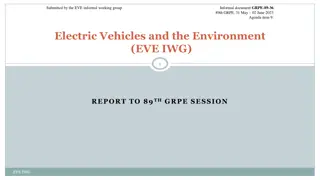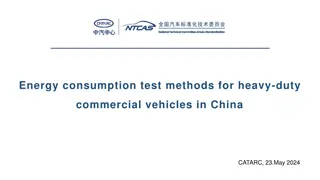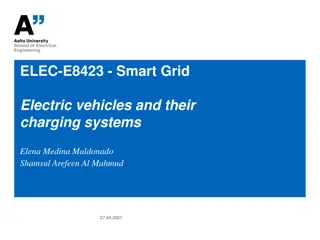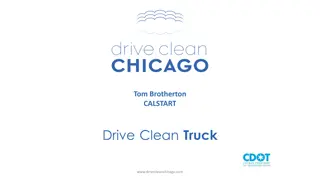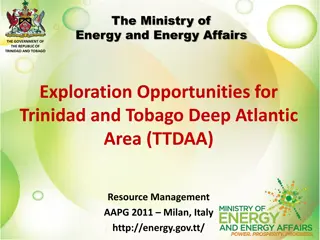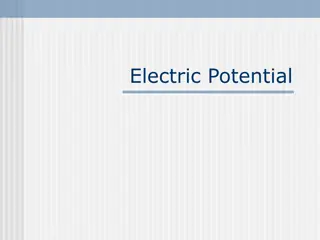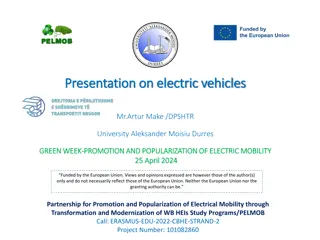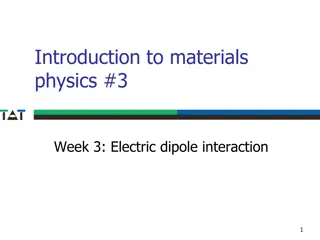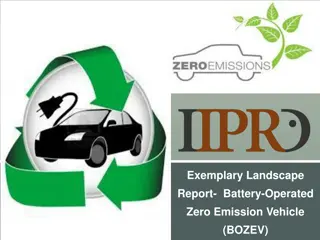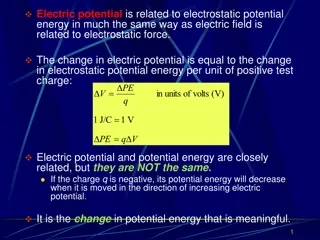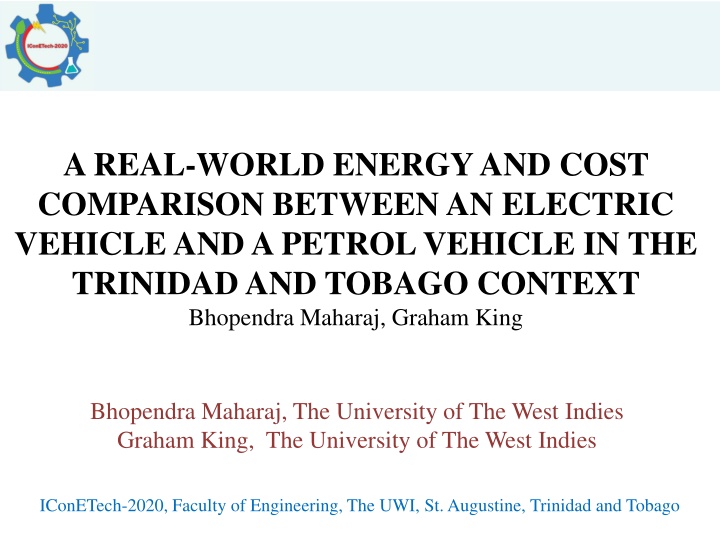
Energy and Cost Comparison between Electric and Petrol Vehicles in Trinidad and Tobago
Assessing the benefits of increasing Electric Vehicles in Trinidad and Tobago by comparing energy usage and costs of electric and petrol vehicles in a real-world context. The study explores different driving cycles and modeling to analyze the potential advantages of EV adoption.
Download Presentation

Please find below an Image/Link to download the presentation.
The content on the website is provided AS IS for your information and personal use only. It may not be sold, licensed, or shared on other websites without obtaining consent from the author. If you encounter any issues during the download, it is possible that the publisher has removed the file from their server.
You are allowed to download the files provided on this website for personal or commercial use, subject to the condition that they are used lawfully. All files are the property of their respective owners.
The content on the website is provided AS IS for your information and personal use only. It may not be sold, licensed, or shared on other websites without obtaining consent from the author.
E N D
Presentation Transcript
A REAL-WORLD ENERGY AND COST COMPARISON BETWEEN AN ELECTRIC VEHICLE AND A PETROL VEHICLE IN THE TRINIDAD AND TOBAGO CONTEXT Bhopendra Maharaj, Graham King Bhopendra Maharaj, The University of The West Indies Graham King, The University of The West Indies IConETech-2020, Faculty of Engineering, The UWI, St. Augustine, Trinidad and Tobago
INTRODUCTION AIM: To assess the potential benefits of increasing the proportion of Electric Vehicles in Trinidad and Tobago. BACKGROUND: Trinidad and Tobago s transportation sector. Internal Combustion Vehicles and their drawbacks. Electric Vehicles and their benefits. Electric Vehicles and their drawbacks. IConETech-2020, Faculty of Engineering, The UWI, St. Augustine, Trinidad and Tobago
INTRODUCTION BACKGROUND Electric Vehicles market growth in Norway, China and California. What is Trinidad and Tobago s position on electric vehicles? IConETech-2020, Faculty of Engineering, The UWI, St. Augustine, Trinidad and Tobago
METHODOLOGY Methodology Representative Driving Cycle Development EV & ICE Modelling Analysis IConETech-2020, Faculty of Engineering, The UWI, St. Augustine, Trinidad and Tobago
REPRESENTATIVE DRIVING CYCLE The Trinidad & Tobago Drive Cycle Highway (TTDC) The Trinidad and Tobago Sub- Urban Driving Cycle (TTDC) IConETech-2020, Faculty of Engineering, The UWI, St. Augustine, Trinidad and Tobago
METHODOLOGY ICE & EV Modelling Model Development Vehicle Selection Data Collection Model Validation IConETech-2020, Faculty of Engineering, The UWI, St. Augustine, Trinidad and Tobago
RESULTS ICE Simulation with Trinidad and Tobago Driving Cycle (TTDC) Simulated Fuel Flow Rate for ICE TTDC Highway Simulated Fuel Flow Rate for ICE TTDC Sub-Urban IConETech-2020, Faculty of Engineering, The UWI, St. Augustine, Trinidad and Tobago
RESULTS EV Simulation with Trinidad and Tobago Driving Cycle (TTDC) Simulated Energy Transfer for EV TTDC Highway Simulated Energy Transfer for EV TTDC Sub-Urban IConETech-2020, Faculty of Engineering, The UWI, St. Augustine, Trinidad and Tobago
RESULTS & ANALYSIS Energy Comparison for Simulations with Trinidad and Tobago Driving Cycle (TTDC) Drive Cycle ICE (litres) EV (kWh) TTDC Highway TTDC Sub-Urban Combined Energy Used (kWh) 1.46 0.72 2.18 19.40 2.77 1.1 3.87 3.87 Vehicle Efficiency (kWh/km) 0.72 0.14 Energy Difference in Combined Cycle (kWh) 15.53 (80.1%) IConETech-2020, Faculty of Engineering, The UWI, St. Augustine, Trinidad and Tobago
RESULTS & ANALYSIS Electric Driving Range in Trinidad and Tobago EV battery capacity = 28 kWh ICE fuel storage capacity = 431 kWh Combined distance of the Highway and Sub-Urban TTDC= 26.8km IConETech-2020, Faculty of Engineering, The UWI, St. Augustine, Trinidad and Tobago
RESULTS & ANALYSIS Well to Wheel Analysis The Well to Wheel Analysis by Curran et al. (2014) provided estimates for the Well to Tank stage of the analysis. The simulated results with the TTDC provides the Tank to Wheel portion of the analysis. The two combined provides the full Well to Wheel analysis. IConETech-2020, Faculty of Engineering, The UWI, St. Augustine, Trinidad and Tobago
RESULTS & ANALYSIS Well to Wheel Table Estimate with Combined TTDC Vehicle Usage Vehicle Type/ Mix Tank to Wheel (kJ/km) Well to Wheel (Total) (kJ/km) Tank to Wheel GHG/CO2 (g/km) 200.73 Well to Wheel GHG/CO2 (g/km) ICE/ Crude Oil 2599.14 3299.14 250.73 EV/ Natural Gas 518.67 1718.67 0 130 EV Saving 2080.47 1580.47 200.73 120.73 IConETech-2020, Faculty of Engineering, The UWI, St. Augustine, Trinidad and Tobago
RESULTS & ANALYSIS Emissions and the Paris Agreement Survey results indicated that the average weekly mileage was found to be approximately 342.3km. Average Annual Household Mileage = 17800km Annual CO2 Savings per vehicle = 2.15tons CO2 (Assuming a 10% or 70000 EV s displacement of ICE vehicles) Annual CO2 Savings = 150,500 tons NDC Proportion = 9% IConETech-2020, Faculty of Engineering, The UWI, St. Augustine, Trinidad and Tobago
RESULTS & ANALYSIS Cost of Ownership Comparison of ICE s EV Cost Purchase Price Capital Depreciation [A] Total Energy Cost [B] Total Maintenance Cost [C] Cumulative Cost [A + B + C] ICE EV $229,000.00 $103,050.00 $35,784 $21,805.00 $160,639.00 $259,000.00 $129,500.00 $4,610 $14,151.00 $148,261.20 Total Cost of Ownership per km $1.80 $1.67 Lebeau et al. (2013) method for maintenance cost estimates. All values quoted in TTD. IConETech-2020, Faculty of Engineering, The UWI, St. Augustine, Trinidad and Tobago
CONCLUSION The Well to Wheel EV energy use and CO2 emissions are 52% of its ICE counterpart. A 10% EV penetration could lead to a 9% contribution to the NDC for the Trinidad and Tobago Paris Agreement. The EVs cost of ownership is estimated to be approximately 8% cheaper than ICE vehicles over a five year period. Reduced emissions and pollution in Trinidad and Tobago with the adoption of EVs. IConETech-2020, Faculty of Engineering, The UWI, St. Augustine, Trinidad and Tobago
REFERENCES S.J. Curran, R.M. Wagner, R.L. Graves, M. Keller, J.B. Green, Well-to-wheel analysis of direct and indirect use of natural gas in passenger vehicles, Energy. 75 (2014) 194 203. https://doi.org/10.1016/j.energy.2014.07.035. K. Lebeau, P. Lebeau, C. Macharis, J. Van Mierlo, How expensive are electric vehicles? A total cost of ownership analysis, World Electr. Veh. J. 6 (2013) 996 1007. https://doi.org/10.3390/wevj6040996. IConETech-2020, Faculty of Engineering, The UWI, St. Augustine, Trinidad and Tobago
THANK YOU! IConETech-2020, Faculty of Engineering, The UWI, St. Augustine, Trinidad and Tobago


